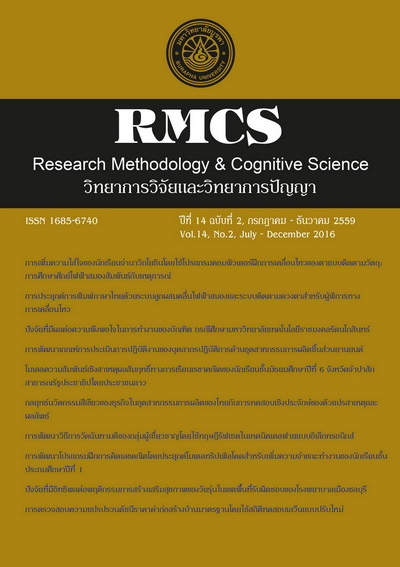การพัฒนาวิธีการวัดฉันทามติของกลุ่มผู้เชี่ยวชาญโดยใช้ทฤษฎีรัฟเซตในเทคนิคเดลฟายแบบอิเล็กทรอนิกส์
Main Article Content
Abstract
การวิจัยนี้มีวัตถุประสงค์เพื่อพัฒนาวิธีการวัดฉันทามติของกลุ่มผู้เชี่ยวชาญโดยใช้ทฤษฎีรัฟเซตในเทคนิคเดลฟายแบบอิเล็กทรอนิกส์ด้วยโปรแกรมคอมพิวเตอร์ และนำวิธีที่พัฒนาขึ้นไปใช้ในการศึกษาสมรรถนะด้านเทคโนโลยีสารสนเทศและการสื่อสารของครูสังกัดสำนักการศึกษา กรุงเทพมหานครในอนาคต (พ.ศ. 2559-2568) ด้วยเทคนิคเดลฟายแบบอิเล็กทรอนิกส์ กลุ่มตัวอย่างเป็นผู้เชี่ยวชาญที่มีความรู้ความสามารถทางด้านเทคโนโลยีสารสนเทศและการสื่อสาร จำนวน 19 คน เครื่องมือที่ใช้ในการวิจัย ได้แก่ แบบสอบถามออนไลน์เกี่ยวกับสมรรถนะด้านเทคโนโลยีสารสนเทศ และการสื่อสารของครู การวิเคราะห์ข้อมูลใช้การคำนวณค่าคุณภาพของการประมาณขอบเขตล่าง ค่ามัธยฐาน และค่าพิสัยระหว่างควอไทล์ ผลการวิจัยปรากฏว่า
1. วิธีการวัดฉันทามติของกลุ่มผู้เชี่ยวชาญโดยใช้ทฤษฎีรัฟเซตในเทคนิคเดลฟายแบบอิเล็กทรอนิกส์ มีกระบวนการ 5 ขั้นตอน ได้แก่ 1) กำหนดคุณสมบัติ จำแนกคุณสมบัติ และผลลัพธ์คุณสมบัติของเรื่องที่สนใจ 2) แสดงตารางการตัดสินใจ 3) กำหนดกฎการตัดสินใจ 4) คำนวณค่าคุณภาพของการประมาณขอบเขตล่าง และ 5) กำหนดเกณฑ์การวัดฉันทามติของกลุ่มผู้เชี่ยวชาญ ส่วนผลการประเมินโปรแกรมคอมพิวเตอร์วัดฉันทามติฯ โดยภาพรวมชี้ให้เห็นว่า มีความเหมาะสมอยู่ในระดับมากและเป็นที่ยอมรับของผู้เชี่ยวชาญ
2. สมรรถนะด้านเทคโนโลยีสารสนเทศและการสื่อสารของครูสังกัดสำนักการศึกษากรุงเทพมหานครในอนาคต (พ.ศ. 2559-2568) ประกอบด้วย สมรรถนะ 6 ด้าน 32 ตัวบ่งชี้ ได้แก่ 1) ด้านความรู้พื้นฐานเทคโนโลยีสารสนเทศ และการสื่อสาร 2) ด้านการวางแผนและออกแบบการเรียนรู้ในห้องเรียน 3) ด้านการบูรณาการเทคโนโลยีด้านการเรียนการสอน 4) ด้านความรู้พื้นฐานการวัดและประเมินผลการเรียนรู้ 5) ด้านการเรียนรู้อย่างครูมืออาชีพ และ 6) ด้านสังคมและค่านิยมด้านศีลธรรมจริยธรรม
3. จำนวนตัวบ่งชี้ที่ได้รับฉันทามติจากกลุ่มผู้เชี่ยวชาญระหว่างวิธีที่พัฒนาขึ้นกับวิธีการวัดฉันทามติแบบเดิมไม่แตกต่างกัน
ดังนั้น วิธีการวัดฉันทามติของกลุ่มผู้เชี่ยวชาญโดยใช้ทฤษฎีรัฟเซต จึงเป็นทางเลือกหนึ่งในการวัดฉันทามติของกลุ่มผู้เชี่ยวชาญที่ให้ความสำคัญกับความคิดเห็นของผู้เชี่ยวชาญทุกคน
The objectives of this research were to develop an expert panel consensus measurement procedure using rough set theory in the e-Delphi technique, and to study the competency of information and communication technology for teachers under the Department of Education, Bangkok, in the future (2016-2025 AD) using the e-Delphi technique. The samples were composed of nineteen experts in information and communication technology. An online questionnaire on the competency of information and communication technology for teachers was used to collect data. The data were analyzed using the lower approximation, median, and interquartile range.The results were as follows:
1. The expert panel consensus measurement procedure using rough set theory in the e-Delphi technique consisted of five steps as follows: 1) formulate the attributes, classify attributes, and the results of attributes; 2) present the decision table; 3) formulate the decision rule; 4) calculate a quality of the lower approximation; and 5) formulate the criteria consensus measurement of the expert panel. The consensus measurement of the expert panel using rough set theory computer program was found to be appropriate, and the overall was recognized and acknowledged by the experts.
2. The competency of information and communication technology for teachers under the Department of Education, Bangkok, in the future (2016-2025 AD) were six competencies and thirty-two indicators: 1) basic information and communication technology knowledge; 2) planning and design of learning in the classroom; 3) integration of technology in teaching; 4) basic knowledge of measurement and evaluation for learning; 5) professional teacher; and 6) social, values and moral ethics.
3. The number of indicators from the expert panel consensus measurement procedure using rough set theory with an original consensus measurement showed no difference.
The result indicated that the expert panel consensus measurement procedure using rough set theory was an alternative for consensus measurement among experts which focuses on all expert opinions.
Article Details
References
Avery, A. J., Savelyich, B. S. P., Sheikh, A., Cantrill, J., Morris, C. J., Fernando, B., Bainbridge, M., Horsfield, P., Teasdale, S. (2005). Identifying and establishing consensus on the most important safety features of gp computer system: e-delphi study. Informatics in Primary Care, 13(1), 3-11.
Fong, S. F., Ch’ng, P. E., & Porc, F. P. (2013). Development of ICT competency standard using the Delphi Technique. In Proceeding International Educational Technology Conference. (pp. 327-341) Lumpur: Malaysia.
Gracht, H. A. (2012). Consensus measurement in delphi studies review and implications for future quality assurance. Technological Forecasting & Social Change, 79(1), 1525-1536.
Institute of Museum and Library Services. (2009). Museums, libraries, and 21st century skills.Retrieved September 15, 2014, from http://www.imls.gov/assets/1/AssetManager/21stCenturySkills.pdf
Pawlak, Z. (1997). Rough set approach to knowledgebased decision support. European Journal of Operational Research, 99(1), 48-57.
YangCharoenyeunyong, S., Chadcham, S., & Panthong, K. (2016). Development of the Criteria for Assessing Employee Performance in the Automotive Parts Industry. Research Methodology & Cognitive Science, 14(2), 43-58.
UNESCO. (2011). UNESCO ICT Competency framework for teachers. The United Nations Educational, Scientific and Cultural Organization: Paris.
